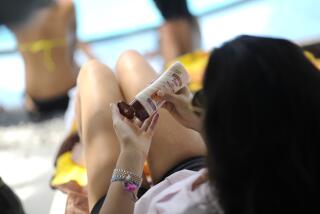Sunscreen is evolving, but many basics remain the same
IF youâve cruised the sunscreen aisle at the grocery or drugstore lately, you know the choices seem almost endless. Spray, cream or nongreasy lotion? SPF 15, 45 or something in between?
Now factor in this seasonâs new offerings -- a sunscreen ingredient called Helioplex and a new sunscreen pill -- and recent class-action lawsuits charging that the sunscreen makers have inflated the protective qualities of their products.
You might be tempted to throw up your hands and forget the sunscreen altogether.
But wait. Although sunscreens arenât perfect, they do help reduce the number of skin cancer cases, estimated at a million a year in the United States, according to the Skin Cancer Foundation and the American Academy of Dermatology, which recently reaffirmed their stands on the importance of sunscreens. Itâs crucial to choose the right product and to use it correctly.
This year, some sunscreens include Helioplex, a substance developed by Neutrogena. Itâs in five of its sunscreen products -- UltraSheer Dry-Touch Sunblock SPF 55; Age Shield Sunblock SPF 30 and 45; and Fresh Cooling Body Mist Sunblock SPF 30 and 45.
Helioplex combines two existing sunscreens, avobenzone and oxybenzone, which block UVA (ultraviolet A) and UVB (ultraviolet B) rays. But the avobenzone is in a more stable form, according to the maker, so it doesnât lose its effectiveness with exposure to sunlight.
âI would call it an improvement over what is on the market for UVA protection,â said Dr. Bruce Brod, a spokesman for the American Academy of Dermatology, who practices in Lancaster, Pa., and is a clinical associate professor of dermatology at the University of Pennsylvania School of Medicine, Philadelphia.
UVA rays cause wrinkles and other skin damage and are also thought to contribute to some skin cancers. UVB rays are the primary cause of sunburns and skin cancers. The Food and Drug Administration has SPF standards for UVB but is still developing UVA standards.
Meanwhile, French cosmetics giant LâOreal is in discussions with the FDA to get approval to market its potent UVA filter, Mexoryl, spokeswoman Jennie James said. Itâs already an ingredient in sunscreens sold outside the U.S.
Mexoryl âlooks good,â Brod said. âIt is in widespread use and already approved in Canada, Europe and other countries.â
Another option is Heliocare, a food supplement derived from a Honduran fern, taken orally in pill form to reduce the damage done by the sun, said Jane Kilbourn, a spokeswoman for Miami-based Ivax, which began selling the supplement in this country in December.
Itâs marketed as a food supplement, she said, so the FDA does not regulate it as a drug. In one study of 10 patients, published in January 2004 in the Journal of the American Academy of Dermatology, researchers found the supplement effective in reducing sunburn cells.
âThey were able to demonstrate in a small group of patients in a laboratory setting [Heliocare] reduced sunburn and also seemed to reduce the effect on the DNA damage on the skin,â said Brod, who is familiar with the study but not involved in it. But he noted that âthere are a lot of unknowns. There are no long-term studies to see how effective it is in real-world use.â
Thereâs also sun-protective clothing, in which the fabric has been treated with sunscreen. It is worth a try, Brod said, although it can be pricey: A treated T-shirt can cost $60.
Do-it-yourself clothing protection also is possible with SunGuard, a laundry additive with a chemical that can turn everyday clothes into clothes with an ultraviolet UVA or UVB protection factor of 30, according to the maker, Phoenix Brands. A package costs about $2 and is sold in discount stores. Itâs added to regular laundry detergent, and the sun protection lasts up to 20 washings, the company claims.
âI donât think [SunGuard] should be relied on as a sole method of sun protection, but I think itâs a help,â Brod said. âMy motto is: Protect yourself from the sun in as many ways as you can.â
That also means knowing how to use sunscreens, said Dr. Arnold Klein, a spokesman for the Skin Cancer Foundation and a Beverly Hills dermatologist.
âPeople do not use enough,â he said. When applying sunscreen to your body, aim for âa shot glass or a shot glass and a half,â he said. Thatâs about an ounce to an ounce and a half. âAnd at least two tablespoons for the face.â
Klein also advises:
* Apply sunscreen half an hour to 45 minutes before sun exposure to allow it to penetrate; reapply it every two hours.
* Avoid the sun when its rays are strongest, between 11 a.m. and 4 p.m.
* Wear a hat.
* If you donât want to pay the price for sun-protective clothes, âjust go to a tightly woven fabric in a dark color,â he said.
* As for SPF, pick one that is 15 or above, Klein and other experts agreed. Babies younger than 6 months should be kept out of the sun, according to the American Academy of Pediatrics, and sunscreens with SPFs of at least 15 should be used on older children. And realize, âthe SPF is only for [ultraviolet] B protection, not A,â Klein said.
* Be especially careful about sun protection if you are taking certain drugs, such as thiazide diuretics for blood pressure, or oral antibiotics, some of which can make you more photosensitive. âA lot of people use retinoids [such as retin-A creams] on their faces, which make you more sensitive,â Klein said.
*
Healthy Traveler appears every other week. Kathleen Doheny can be reached at [email protected].


